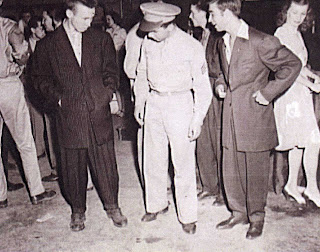2 New Street Trends
The Japanese street trends are pretty hot and inspired for spring 2010 runway. The designers got the ideas from youth’s street outfit in Harajuku and Shibuya in Tokyo and filter them in their own design.
Pattern Play

The 20th Century Street Trends
Zoot Suits
Zoot Suit is a man’s suit, which characterizes by a long loose jacket with big padded shoulder and high-waisted tapering trousers, wide-leggged, and tight-cuffed. This style was popular in 1930s and 1940s by African Americans, Mexican Americans, Puerto Ricans, Italian Americans and Filipino Americans. It usually wears with felt hat with a long feather and French style shoes. The zoot suiter wear in special occasions, such as a dance or a birthday party. The oversized suit was an extravagant personal style and a declaration of freedom and auto-determination, although retired servicemen and the middle class viewed it as a rebellious garment for the era.

North East R&R Society, 1973, www.oldmemorieslosangeles.us


John Paul Gautier, RTW fall 2009, style.com

The Teddyboy emerged in the 1950s as Britain was coming to the end of post-war austerity and represented the first face of British youth culture..Teddy Boys are an English youth subculture that created a distinctive style by wearing clothes inspired by the Edwardian period that the tailors of Savile Row attempted to reintroduce after world war two. The Teddy Boys came about as a result of a newspaper headline that shortened Edward to Teddy and subsequently to Teddy Boys. The clothing that the Teddy Boys wore was designed to shock their parents' generation. It consisted of an Edwardian style drape jacket, much too 'camp' for a working class man, suede Gibson shoes with thick crepe soles, narrow 'drainpipe' trousers, a smart shirt and a loud tie - usually of the 'Slim Jim' or bootlace type.

Louis Vuitton, spring 2010, style.com

Topshop, spring 2009 RTW, style.com
Beatniks

Beatniks are part of a sociocultural movement in the 1950s and early 1960s that subscribed to an anti-materialistic lifestyle in the wake of World War II. The typical beatnik look characterized by loose-fitting hooped T-shirt, black beret, goatee beard, sunglasses, poetry book in hand; for chicks, subtract the beard and add deep fringe and heavy eye make-up. (Retrogalaxy) Fashions for women included black leotards and wearing their hair long, straight and unadorned in a rebellion against the middle-class culture of beauty salons. (Wikipedia)
The style of dress included lots of black and white, turtleneck tops, peddle-pushers for girls, tight, straight-leg trousers for men, berets, ballet pumps for girls, and dark sunglasses.

Betsey Johnson, RTW fall 2008, style.com

Mui Mui, RTW fall 2005, style.com
Mods

Young Women in Mod London Fashions
On a London street, one young woman defies fashion by continuing to wear the miniskirwhile two other young women wear the newer maxiskirt in 1967, December 20,1967,CORBIS.com
Mod is a subculture that originated in London in the late 1950s and became popular in the early 1960s. Mod characterized by tailor-made Italian suits, mohair clothes, thin ties, button-down collar shirts, wool sweaters, and pointed-toe leather shoes.Female mods dressed in men’s trousers or shirts, flat shoes, put on little make-up and had short haircuts. They pushed the boundaries with miniskirts which got progressively shorter between the early and mid-1960’s. As the female mod fashion became more commercialized, slender model Twiggy beganwearing the high-fashion mod look in the 1960's. (Wikipedia)

Lacoste, RTW spring 2009, style.com

Abaete, Fall 2007 RTW, style.com

Meditating Hippie, Cape Town, South Africa, 1967
Hippie is a subculture that originally began in United Stated during 1960s by a youth movement. Hippie culture spread worldwide through a fusion of rock music, folk, blues, and psychedelic rock. Hippies often chose brightly color clothing and the styles for the most part were loose and non-constricting. Styles are bell-bottom pants, vests, tie-dyed garments, dashikis, peasant blouses, and long, full skirts with nature-inspired patchwork, African and Latin American prints, and several other accessories.

Dries Van Noten, spring 2008 RTW, style.com

Rich Hippie, NY fashion week spring 2009, instyle.com
Matthew Williamson (far left), Diane von Furstenberg (center), Anna Sui (right).

Set of Sergent Pepper's Lonely Hearts Club Band in Disco Fashion
September 1978, Michael Childers/Sygma,
www.Corbis.com
Disco looks began in the 1970s and was memorable for its hot pants look and Spandex tops. Shiny clinging Lycra stretch disco pants in hot strident shiny colours with stretch sequin bandeau tops were often adaptations of professional modern dance wear that found itself making an impact in discos as disco dancing became serious. Gold lame, leopard skin and stretch halter jumpsuits and white clothes that glowed in Ultra Violet lights capture the 70s Disco fashion perfectly. (Fashion-era)


Balmian, spring 2010 RTW, style.com

Mana-sama Punk Style Cosplay by Fallen Angle, www.deviantart.com
Punk first emerged in the mid 1970s in London as an anarchic and aggressive movement. Street punks usually have the most colorful of outfits, out of all forms of punk. Usually street punks wear leather jackets or denim jackets with studs and band logos or beliefs either painted or sewn on. Street punks also usually wear plaid pants, or tight stretch jeans, along with boots like doc martens. "Mohawks" and "Liberty Spikes" are among the many hair styles worn, as well as hair dyed radical colors.

Vivienne Westwood, spring 2010, style.com

Hip Hop

Hip hop clothes were originated with African American youth in Los Angles, New York, Chicago, and Philidelphia. Hip hop clothes firstly worn by big hip hop stars like Run-DMC and LL Cool J in the 1980s. They were wearing big glasses, many rings, sneakers with ‘phat’ shoelaces, Big gold necklaces, and jewellery.. The haircut was another symbol of the hip hop trend: some singers were having Jheri curls; others had hi-top fade. But the Black Pride movement was the most powerful trend of the hip hop culture in the ‘80s. It was symbolized by dreadlocks, Africa chains and black-green-and-red hip hop clothes.
